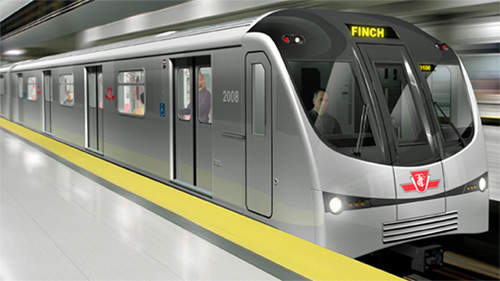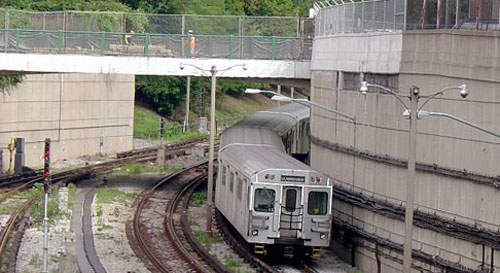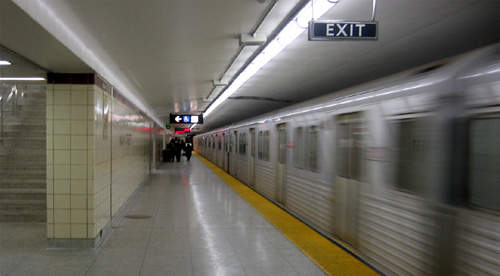Canada’s largest city, Toronto, is home to a growing population of
more than 5 million, and has an expanding subway system to aid passenger
movement. The Toronto Subway serves more than 850,000 passengers each day.
The first subway route of the Toronto Transit Commission opened in March
1954, between Eglinton and Union on a 7.4km (4.6 mile) alignment, and this has
been extended six times since to create the 31km (19.3 mile)
Yonge-University-Spadina route.
The network currently consists of three standard subway routes and the
Scarborough Rapid Transit link, bringing the city a 70km transit system. The
subway is now the backbone of Toronto’s transport system, with 149 bus
and light rail routes feeding subway services.
The Toronto Transit Commission also operates light rail routes and buses,
while the GO Transit suburban railway service links with the subway at Union
station and other points across the network.
THE PROJECT
Following the opening of the Sheppard Subway in November 2002, the Toronto
Subway has stood still in terms of route extensions. However, the network
continues to be upgraded, with new escalators at the stations and investment in
modern rolling stock.
There are plans for an extension of the Yonge-Spadina route north to York
University and the Vaughan Corporate Centre – with Ontario Government
pledging CAD $670m towards the project.
The Scarborough Rapid Transit (RT) is now under pressure from overcrowding,
and is said to require major investment if it is to continue running beyond
2015, whilst there are also plans to extend the Sheppard Line into
Scarborough.
INFRASTRUCTURE
The Toronto Subway is built to a unique gauge of 1,495mm, rather than the 1,435mm standard and is powered at 600V DC, with trains collecting current from a third rail. The entire network has been laid as a two-track system, although at certain locations an additional third track has been laid for train storage and reversal.
Four routes are operated by the TTC: Yellow Line from Yonge-Spadina (31km,
32 stations), Green Line from Bloor-Danforth (27.5km, 31 stations), Purple Line
from Sheppard to Don Mills (6.4km, five stations) and Blue Line Scarborough RT
(6.4km, six stations).
The most recent route opening was the Sheppard Subway. This line opened in
November 2002 and is now the subject of a potential extension to link with the
Scarborough RT in Scarborough (west Toronto).
ROLLING STOCK
After the New York and Mexico Subways, Toronto is the third busiest mass
transit system in North America. To accommodate massive ridership figures, a
large fleet of 684 subway cars (on the Yellow, Green and Purple lines),
together with a fleet of 28 intermediate capacity trains on the Scarborough RT,
56 subway works cars and 6 RT works cars are needed. Between 1995 and 2001, the
fleet was joined by an additional 372 accessible subway cars.
The oldest cars in service were built by Hawker-Siddeley, Canada, in
1974-75, with a further 136 vehicles coming from the same manufacturer in
1976–79. These are all due to be replaced by 2011 when a new order with
Bombardier Transportation is fulfilled.
The order with Bombardier was placed in December 2006 for the delivery of
234 cars – to be formed into 39 trains –in a contract worth
CA$431m. With the addition of spares and equipment, Toronto Transit Commission
is spending CA$473m.The first cars are planned for delivery in 2009, with the final vehicles rolling out of Bombardier’s Ontario factory in 2011. Compared with previous vehicles the new trains will be significantly different, featuring a raked front-end design and open gangways to allow passengers to walk through the train (the first in North America to be built in this way). The trains will also feature electronic information systems, new security features and increased reliability.
SIGNALLING AND COMMUNICATIONS
The new trains will feature an electronic information system which includes
automated audio station announcements, active subway maps showing the direction
of travel, the next station and which side the train doors open at each
station. The driver’s cab has a two-way intercom to communicate with
passengers.
For communication between the Transit Control Centre and trains, the Wayside
System has been installed on the subway. This allows control to speak directly
with a single train, several trains at once or the entire line. This is only
used on the Yellow, Green and Purple lines, as the Scarborough RT continues to
use a single-channel UHF system.
There are 800 CCTV cameras around the 69 stations of the TTC subway network
and special constables are employed to improve security. Since the 1980s trains
have been equipped with a Passenger Assistance Alarm.
THE FUTURE
With its 70km network of four lines, the Toronto Subway provides a vital
service for the city, fed by the bus and light rail networks. Two extensions
have been proposed – extending Yellow Line extended north to Vaughan
Corporate Centre, whilst the Sheppard Line (opened 2002) is also earmarked for
a westbound extension to Scarborough and a connection with the Scarborough
RT.
The introduction of the new Bombardier sets in 2009–11 will refresh the
image of the rolling stock and allow older 1970s units built to be
withdrawn.







